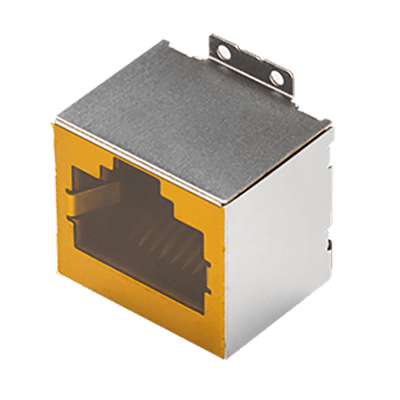What Is a Modular Jack?

A modular jack is a connector used for connection.
It can be detached with a single touch and is often used as a connector for interfaces. Also called modular jacks or modular plugs, they are connected to modular cables. It can be used for telephone lines, ADSL communication, and LAN lines.
Due to their superior characteristics, they are widely used in a variety of industries and application areas.
Uses of Modular Jacks
Modular jacks are used to connect lines for interfaces. Available as a square exposed type or embedded as a panel in a wall, they are a connection tool with numerous uses. The size, shape, and performance vary depending on the standard, so it is required to use the right one for the application.
1. Telecommunication Equipment
Modular jacks play an important role in telecommunications equipment. In particular, they are used to connect Ethernet cables in networking equipment such as modems and routers. This enables high-speed data transmission.
2. Computers
Modular jacks are also frequently used in computer equipment such as PCs and servers. For example, they are used to connect USB ports and monitors to transfer data and display screens.
3. Household Appliances
Modular jacks also have a very large number of applications in household appliances. For example, they are used to connect all kinds of electrical appliances such as telephones, home game consoles, and televisions.
4. Automotive Industry
Modular jacks also play an important role in the automotive industry. They are used to connect various electronic devices, sensors, control units, and other devices in the car to improve the functionality and performance of the vehicle. They are also used for in-vehicle communication and entertainment systems.
Principle of Modular Jacks
Modular jacks are made of flame-retardant plastic. Signal lines are drawn inside, and the wires are color-coded for the number of poles in each standard.
Consisting of multiple pins and corresponding sockets, modular jacks typically consist of eight metal pins and sockets with eight corresponding holes. This allows the male plug to hook onto the female one with a claw at the top of the plug, which clicks into place when connected and cannot be pulled out immediately. To pull it out, push the claw down and pull it out.
There are several standards for modular jacks. The 6-pole, 2-prong connector with 6 terminals is commonly known as RJ-11, and the 8-pole, 8-prong connector with 8 terminals is known as RJ-45, mainly used for LAN. The wiring of 8-pole, 8-conductor for LAN generally follows T568A or T568B of the American National Standards Institute.
Some connectors allow multiple phone lines or LAN connections with a single modular jack. Special tools are required to replace modular jacks.
Characteristics of Modular Jacks
Modular jacks are characterized by their ease of removal and connection. Since the pins and sockets engage securely, there is little signal loss or contact failure, providing a highly reliable connection. In addition, the connector locks automatically when inserted, preventing accidental disconnection.
Because modular jacks are standardized, they are also highly compatible between different devices and systems. This is useful when different devices need to be combined in various industries and applications. For example, modular jacks are used in a wide variety of equipment such as televisions, telephones, and computers, and are a common standard to ensure compatibility.
Furthermore, by combining pins and sockets, multiple signals can be connected at once, thus contributing to more efficient wiring. This not only reduces wiring complexity and enables efficient wiring design, but also makes it easy to accommodate different signals and protocols by changing connector shapes and sizes.